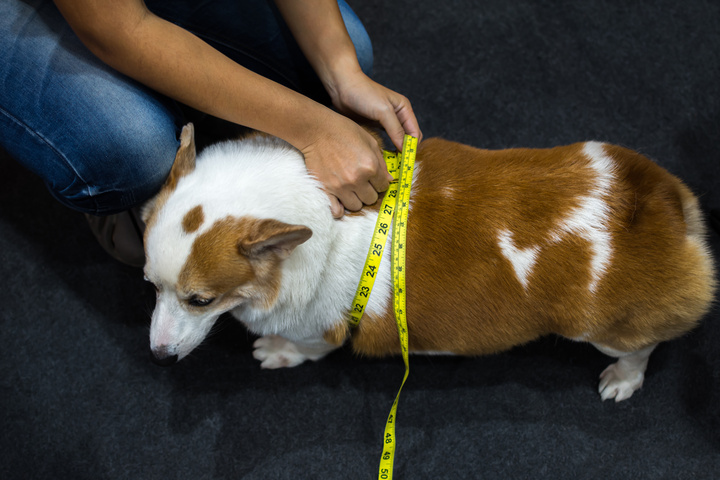Our dogs depend on us for food, water, shelter, and protection. Sometimes, we might think that a little extra scoop of food here and there or a few table scraps is a way to show our furry friends that we love them. Sadly, nothing could be further from the truth.
Many dog breeds are predisposed to rapid fat gain, which can become a major health problem if left unchecked. Weight gain is also common as dogs age. Learning to assess your dog’s weight is important, and taking steps to help your furry friend be as healthy as possible is a true sign of pet parent love.
Obesity is a major health risk for dogs
Obesity is a major issue with domesticated dogs, especially in the Western world. According to the Association for Pet Obesity Prevention, more than 50% of dogs in America are overweight.
Overweight dogs, like humans become more susceptible to various health conditions, including.
Joint problems. Extra pounds put tremendous strain on a dog’s joints, leading to mobility issues and arthritis. Does your pup struggle to get up and down or walk? Extra pounds could be the root issue.
Heart disease. Obesity puts a strain on the heart, leading to issues such as poor cardiac output and pulmonary function, as well as hypertension.
Diabetes. Just like in humans, overweight dogs are at higher risk of developing diabetes. Recent reports show an upward trend in diabetes in dogs.
Respiratory issues. Excess weight can make it harder for a dog to breathe properly, especially if they already have respiratory conditions.
Skin problems. Overweight dogs may develop skin folds, which are opportunistic for fungal issues and skin conditions.
Decreased quality of life. An overweight dog may have less energy, reduced playfulness, and decreased quality of life.
Shortened lifespan. Obesity is linked to a shorter lifespan in dogs, just as in humans.
According to Dr. Carol Osborne, a veterinarian at Chagrin Falls Pet Clinic in Ohio,
“Being just 10% overweight decreases a dog’s lifespan by one-third and predisposes him to heart, kidney, and liver disease as well as diabetes, arthritis, and cancer.”
How to tell if my dog is overweight
Here are some ways to tell if your pup is carrying too many extra pounds.
Get a good look. Look at your dog from above and from the side. A healthy weight dog should have a noticeable waist behind the ribs when viewed from above, and you should be able to feel the ribs easily without excess fat covering them. Conduct this visual check regularly to keep your pup as healthy as possible.
Feel for fat. Run your hands over your furry friend’s body, feeling for areas of fat accumulation, especially around the ribcage, hips, and base of the tail. If you can feel a thick layer of fat, your dog may be overweight.
Activity check. Excess weight might be to blame if your dog is lethargic, has difficulty breathing, getting up and down, or tires easily during exercise.
Breed standard comparison. Do you have a pure bred dog? Some breeds have specific standards for weight and body condition. Comparing your dog to these standards can give you an idea of whether it is overweight.
Regular weigh-in. Regularly weigh your dog using a scale. Your vet can tell you your dog’s ideal weight based on breed and body type. If your dog consistently weighs more than this, it might be overweight.
Find your dog’s body condition score
Many veterinarians prefer to use the body condition score, which considers a dog’s frame, to determine whether a weight loss plan is in order. Here is how to determine your dog’s body condition score at home.
( If Kate can reproduce something like this and call it, Find Your Dog’s Shape
How to score your dog
Use the pictures above as a guide to find your furry friend’s body condition score.
Step 1
Run the palms of your hands gently along your dog’s chest and rib cage. Check to see how easy it is to feel the ribs and other bony parts. Is there a layer of fat over the ribs, or are the ribs visible? If your dog is at an ideal weight, the ribs should be easily felt – not seen – with gentle pressure.
Step 2
Take a look at your pup from the side. Find where the chest cavity transitions to the belly and joins the hind lefts. Does the area appear tapered? There should be a slight abdominal tuck for an ideal body condition score. Keep in mind that this can also be somewhat breed-dependent.
Step 3
Look at your dog from above and check for a tapered waistline. Dogs with good body condition scores should have a slight “hourglass” shape. Dogs carrying excess weight will be more oval or rectangular from above.
If you have determined that your pup is outside the ideal weight range, it is time to start a program to get it there. Don’t hesitate to contact your veterinarian for help; they can recommend a program, food type, etc., to help your pup be as healthy as possible.
Check out our post on helping your dog lose weight here ( link to post on helping your dog lose weight)






